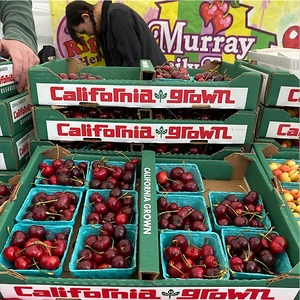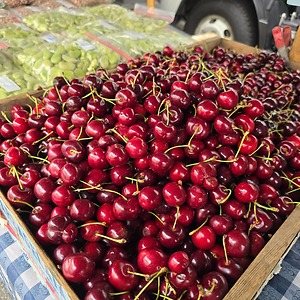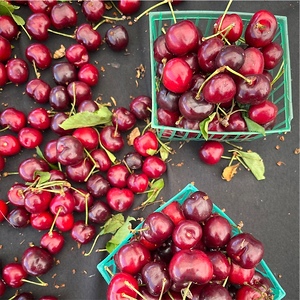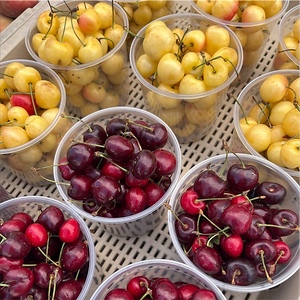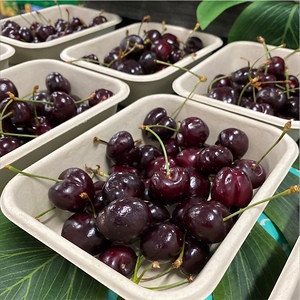

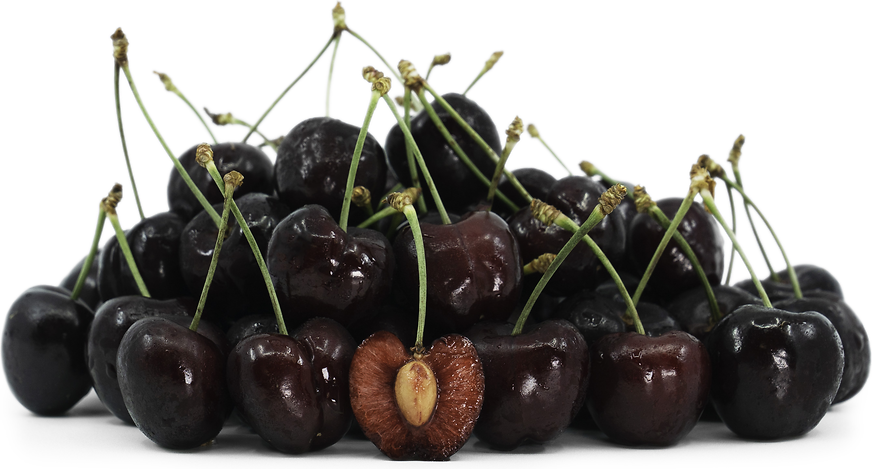
Brooks Cherries
Estimated Inventory, lb : 0
This item was last sold on : 06/14/25
Description/Taste
Brooks cherries are a medium to large varietal, averaging 2 to 3 centimeters in diameter, and have a uniform and symmetrical, round, ovate, to cordate shape. The fruits are attached to short and slender, fibrous green stems reaching 2 to 4 centimeters in length, and some fruits may showcase a dark red suture line extending vertically down the center. The cherry’s skin is glossy, taut, and smooth, ranging in color from vibrant red, red with light-colored mottling to dark red, almost black. The skin is also semi-thick and somewhat tough, creating a snap-like consistency when consumed. Underneath the surface, the flesh is bright red with flushes of dark red surrounding the pit cavity and has a firm, crisp, and aqueous texture. There are also white fibers and a central semi-freestone pit that is inedible and should be discarded in the flesh. Brooks cherries contain some acidity, creating a balanced sweet-tart flavor with tangy, fruity, and blackberry nuances.
Seasons/Availability
Brooks cherries are available in the mid to late spring in California. In the Pacific Northwest, the cherries are generally in season in the late spring to early summer.
Current Facts
Brooks cherries, botanically classified as Prunus avium, are an early-season variety belonging to the Rosaceae family. The modern cultivar grows on trees that can reach 4 to 5 meters in height and is a hybrid variety developed for its flavor, early-ripening, and firm nature. Brooks cherries were bred at the University of California Davis in the late 20th century as an improved variety with low chilling requirements and can be grown in warmer climates, well-suited for Central California. The sweet cherries are one of the first varieties to ripen in the mid-spring, approximately 10 to 14 days before the famous bing cherry, and have a favorable, firm texture with a sweet and tangy, fruity taste. In the modern-day, Brooks cherries represent a new era of early-maturing cherries sold domestically and internationally. Mid-spring traditionally marked a gap in the international cherry market, and with the creation of early varieties such as Brooks cherries, California growers are able to export their cherries at high prices to meet the international demand. Local Californian cherry enthusiasts also favor Brooks cherries for their large size and quality, rich flavor.
Nutritional Value
Brooks cherries are an excellent source of anthocyanins, compounds found within the pigments of the fruit that contain antioxidant-like properties to reduce inflammation and protect the cells against free radical damage. The fruits also provide potassium to balance fluid levels within the body, vitamins A and C to strengthen the immune system, vitamin K for faster wound healing, and lower amounts of fiber, iron, copper, manganese, calcium, and magnesium.
Applications
Brooks cherries have a balanced, sweet-tart flavor well suited for fresh eating and incorporating into baked goods. The cherries can be consumed straight, out of hand, discarding the pit, or they can be blended into smoothies and pressed into juice. It is important to note that the pigmented crimson juice will stain clothing and some surfaces. Brooks cherries can also be chopped into salsa, tossed into fruit and green salads, mixed into coleslaws, pureed into barbeque sauce, or infused into vinaigrettes, syrups, and other sauces. In addition to fresh preparations, Brooks cherries have a firm flesh that holds up well to baking. The cherries are frequently used in pies, chocolate cakes, cheesecakes, tarts, and scones, or they are simmered into fillings, preserves, and jams. Brooks cherries can also be blended into ice cream or covered in brandy and lit on fire to create a caramelized cherries jubilee. Beyond sweet applications, Brooks cherries are ideal for stuffing into duck or pork as a savory-sweet filling and are often mixed with onion, bacon, and sage. Brooks cherries pair well with cheeses such as brie, feta, burrata, and mascarpone, nuts including almonds, pistachios, and hazelnuts, basil, fennel, arugula, yogurt, dark chocolate, and berries including blackberries, blueberries, and raspberries. Whole, unwashed Brooks cherries will keep up to one week when stored as dry as possible in the coldest part of the refrigerator with good air circulation. It is recommended to keep the stems attached for the best storage. Brooks cherries can also be frozen, dried, or canned for extended use.
Ethnic/Cultural Info
Brooks cherries are a preferred variety grown in the southern San Joaquin Valley. The cultivar has an early ripening time, quality flavor, and low chill requirements, allowing it to be produced in warm, dry climates that traditionally could not grow other cherry varieties. The southern San Joaquin Valley includes most counties found in the Central Valley, including Kern, Tulare, Fresno, Merced, Madera, and Kings, and the region is primarily rural with family-owned farms. In this region, Brooks cherries are a popular variety for u-pick farm experiences. The cherries ripen in the mid to late spring, one of the first cultivars available each year, and have a balanced, sweet-tart flavor well suited for fresh eating. U-pick opportunities are a family-friendly activity that allows visitors to enjoy the seasonal fruits directly from the tree. Many farms also provide ladders to pick cherries off the taller branches for a larger harvest. In addition to u-pick experiences, several cherry farms in the southern San Joaquin Valley also sell harvested baskets of cherries, baked goods, dried fruits, and nuts, or homemade syrups as souvenirs. Murray Family Farms offers u-pick experiences and runs the Little Purple Barn, a pit-stop featuring fresh fruits and dried goods. The farm grows over thirty different varieties of cherries, but Brooks cherries were one of the first cherry varieties that the farm grew. Brooks cherries are also rumored to be Mrs. Murray’s favorite cherry.
Geography/History
Brooks cherries were developed by Paul E. Hansche at the University of California Davis in 1969. The variety was created from a cross between rainier and burlat cherries and was studied for several years through multiple field trials, first bearing fruit in 1976. The field trials took place at the university-run Wolfskill Experimental Orchard in Winters, California. In 1978, a patent was filed to distinguish the new variety, granted in 1989 under US Plant Patent #6676, but the patent later expired in 2007 and was not renewed. Brooks cherries were released to commercial markets in the late 1980s and were highly favored as an early-season variety cultivated in warmer climates. Today the cherries are primarily grown in California in the San Joaquin Valley and are also produced on a smaller scale in the Pacific Northwest, Europe, and Australia. When in season, the fruits can be found through farmer’s markets and specialty distributors. The cherries are also seasonally exported to Asian markets for fresh sale.
Recipe Ideas
Recipes that include Brooks Cherries. One
| Food 52 |
|
Chocolate and Cherry Sauce |
Podcast









